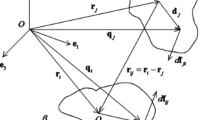Abstract
We investigate the equilibrium points and orbits around asteroid 1333 Cevenola by considering the full gravitational potential caused by the 3D irregular shape. The gravitational potential and effective potential of asteroid 1333 Cevenola are calculated. The zero-velocity curves for a massless particle orbiting in the gravitational environment have been discussed. The linearized dynamic equation, the characteristic equation, and the conserved quantity of the equilibria for the large-size-ratio binary asteroid system have been derived. It is found that there are totally five equilibrium points close to 1333 Cevenola. The topological cases of the outside equilibrium points have a staggered distribution. The simulation of orbits in the full gravitational potential caused by the 3D irregular shape of 1333 Cevenola shows that the moonlet’s orbit is more likely to be stable if the orbit inclination is small.
Similar content being viewed by others
Change history
11 February 2022
A Correction to this paper has been published: https://doi.org/10.1007/s42064-022-0136-2
References
Hirabayashi, M., Morimoto, M. Y., Yano, H., Kawaguchi, J., Bellerose, J. Linear stability of collinear equilibrium points around an asteroid as a two-connected-mass: application to fast rotating asteroid 2000EB14. Icarus, 2010, 206(2): 780–782.
Zeng, X. Y., Jiang, F. H., Li, J. F., Baoyin, H. X. Study on the connection between the rotating mass dipole and natural elongated bodies. Astrophysics and Space Science, 2015, 356(1): 29–42.
Yang, H. W., Zeng, X. Y., Baoyin, H. X. Feasible region and stability analysis for hovering around elongated asteroids with low thrust. Research in Astronomy and Astrophysics, 2015, 15(9): 1571–1586.
Yang, H. W., Tang, G., Jiang, F. H. Optimization of observing sequence based on nominal trajectories of symmetric observing configuration. Astrodynamics, 2018, 2(1): 25–37.
Venditti, F. C. F., Rocco, E. M., Prado, A. F. B. A. Trajectory control around non-spherical bodies modelled by parallelepipeds. Journal of Physics: Conference Series, 2013, 465(1): 012008.
Feng, J. L., Noomen, R., Yuan, J. P. Orbital motion in the vicinity of the non-collinear equilibrium points of a contact binary asteroid. Planetary and Space Science, 2015, 117: 1–14.
Bartczak, P., Breiter, S., Jusiel, P. Ellipsoids, material points and material segments. Celestial Mechanics and Dynamical Astronomy, 2006, 96(1): 31–48.
Jiang, Y., Baoyin, H. X., Li, J. F., Li, H. N. Orbits and manifolds near the equilibrium points around a rotating asteroid. Astrophysics and Space Science, 2014, 349(1): 83–106.
Wang, X. Y., Jiang, Y., Gong, S. P. Analysis of the potential field and equilibrium points of irregular-shaped minor celestial bodies. Astrophysics and Space Science, 2014, 353(1): 105–121.
Aljbaae, S., Chanut, T. G. G., Carruba, V., Souchay, J., Prado, A. F. B. A., Amarante, A. The dynamical environment of asteroid 21 Lutetia according to different internal models. Monthly Notices of the Royal Astronomical Society, 2017, 464(3): 3552–3560.
Yu, Y., Baoyin, H. X. Orbital dynamics in the vicinity of asteroid 216 Kleopatra. The Astronomical Journal, 2012, 143(3): 62.
Chanut, T. G. G., Winter, O. C., Tsuchida, M. 3D stability orbits close to 43. Eros using an effective polyhedral model method. Monthly Notices of the Royal Astronomical Society, 2014, 438(3): 2672–2682.
Chanut, T. G. G., Winter, O. C., Amarante, A., Arajo, N. C. S. 3D plausible orbital stability close to asteroid (216. Kleopatra. Monthly Notices of the Royal Astronomical Society, 2015, 452(2): 1316–1327.
Yu, Y., Baoyin, H. X. Generating families of 3D periodic orbits about asteroids. Monthly Notices of the Royal Astronomical Society, 2012, 427(1): 872–881.
Jiang, Y., Baoyin, H. X. Periodic orbit families in the gravitational field of irregular-shaped bodies. The Astronomical Journal, 2016, 152(5): 137.
Tardivel, S., Scheeres, D. J., Michel, P.. Van Wal, S., Sanchez, P. Contact motion on surface of asteroid. Journal of Spacecraft and Rockets, 2014, 51(6): 1857–1871.
Yu, Y., Baoyin, H. X. Modeling of migrating grains on asteroids surface. Astrophysics and Space Science, 2015, 355(1): 43–56.
Jiang, Y., Zhang, Y., Baoyin, H. X. Surface motion relative to the irregular celestial bodies. Planetary and Space Science, 2016, 127: 33–43.
Va.Wal, S., Scheeres, D. J. The lift-off velocity on the surface of an arbitrary body. Celestial Mechanics and Dynamical Astronomy, 2016, 125(1): 1–31.
Hanuš, J., Durech, J., Brož, M., Warner, B. D., Pilcher, F., Stephens, R., Oey, J., Bernasconi, L., Casulli, S., Behrend, R. et al. A study of asteroid pole-latitude distribution based on an extended set of shape models derived by the lightcurve inversion method. Astronomy & Astrophysics, 2011, 530: A134.
Johnston, W. R. (1333) Cevenola, 2014. https://doi.org/www.johnstonsarchive.net/astro/astmoons/am-01333.html.
Warner, B. D. Asteroid photometry at the palmer divide observatory: results for 1333 Cevenola and 2460 Mitlincoln. Minor Planet Bulletin, 2002, 29: 74–75.
Ni, Y. S., Baoyin, H. X., Li, J. F. Orbit dynamics in the vicinity of asteroids with solar pertubation. The 65th International Astronautical Congress, 2014, 7: 4610–4620.
Jiang, Y., Baoyin, H. X. Orbital mechanics near a rotating asteroid. Journal of Astrophysics and Astronomy, 2014, 35(1): 17–38.
Scheeres, D. J., Ostro, S. J., Hudson, R. S., Werner, R. A. Orbits close to asteroid 4769 Castalia. Icarus, 1996, 121(1): 67–87.
Dullin, H. R., Worthington, J. The vanishing twist in the restricted three-body problem. Physica D: Nonlinear Phenomena, 2014, 276: 12–20.
Werner, R. A., Scheeres, D. J. Exterior gravitation of a polyhedron derived and compared with harmonic and mascon gravitation representations of asteroid 4769 Castalia. Celestial Mechanics and Dynamical Astronomy, 1996, 65(3): 313–344.
Scheeres, D. J., Bellerose, J. The restricted hill full 4-body problem: application to spacecraft motion about binary asteroids. Dynamical Systems, 2005, 20(1): 23–44.
Jiang, Y., Baoyin, H. X., Li, H. N. Collision and annihilation of relative equilibrium points around asteroids with a changing parameter. Monthly Notices of the Royal Astronomical Society, 2015, 452(4): 3924–3931.
Jiang, Y., Baoyin, H. X., Wang, X. Y., Yu, Y., Li, H. N., Peng, C., Zhang, Z. B. Order and chaos near equilibrium points in the potential of rotating highly irregular-shaped celestial bodies. Nonlinear Dynamics, 2016, 83(1–2): 231–252.
Acknowledgements
This research was supported by the National Natural Science Foundation of China (No. 11772356) and China Postdoctoral Science Foundation{General Program (No. 2017M610875).
Author information
Authors and Affiliations
Corresponding author
Additional information
Yu Jiang received his B.S. degree from Peking University, and M.S. degree as well as Ph.D. degree from Tsinghua University. He is now a researcher at State Key Laboratory of Astronautic Dynamics and Tsinghua University. His research interests mainly focus on dynamics and control around multiple asteroid systems, surface motion and soft-landing on minor bodies, space debris, as well as dust dynamics.
Rights and permissions
About this article
Cite this article
Jiang, Y. Equilibrium points and orbits around asteroid with the full gravitational potential caused by the 3D irregular shape. Astrodyn 2, 361–373 (2018). https://doi.org/10.1007/s42064-018-0029-6
Received:
Accepted:
Published:
Issue Date:
DOI: https://doi.org/10.1007/s42064-018-0029-6




